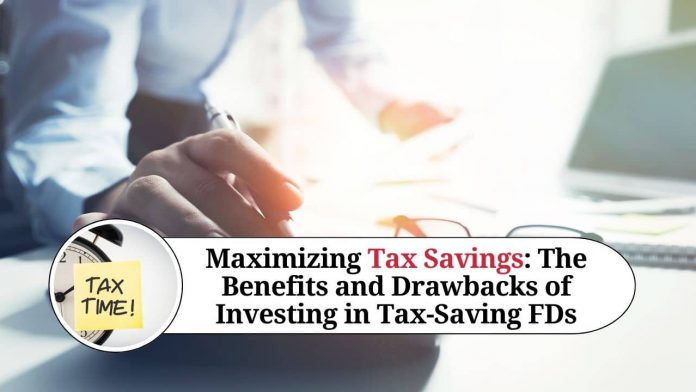Introduction
Saving taxes is an important aspect of financial planning for most people. Tax-saving Fixed Deposits (FDs) are one of the popular options available for people to save on their taxes. In this blog, we will discuss what tax-saving FDs are and how they work, along with their benefits and drawbacks.
What are Tax-Saving FDs?
Tax-Saving FDs are a type of fixed deposit that allows you to save taxes under Section 80C of the Income Tax Act. These FDs come with a lock-in period of five years, and the interest earned on them is taxable. The minimum investment in tax-saving FDs is Rs. 100 and the maximum investment allowed is Rs. 1.5 lakh in a financial year.
How do Tax-Saving FDs work?
Tax-Saving FDs work like any other fixed deposit. You need to invest a lump sum amount for a fixed period, and you earn interest on it. The interest rate on tax-saving FDs is usually the same as regular fixed deposits. However, the key difference is that the investment in tax-saving FDs is eligible for tax deduction under Section 80C.
Benefits of Tax-Saving FDs
Guaranteed returns: Tax-Saving FDs provide guaranteed returns, which means that you know exactly how much you will earn at the end of the lock-in period.
Low risk: Tax-Saving FDs are a low-risk investment as they are backed by the government and are considered to be one of the safest investment options.
Easy to invest: Investing in Tax-Saving FDs is a hassle-free process, and you can do it easily online or by visiting a bank branch.
Drawbacks of Tax-Saving FDs
Lock-in period: Tax-Saving FDs come with a lock-in period of five years, which means that you cannot withdraw the money before the maturity date.
Interest rate: The interest rates on Tax-Saving FDs are usually lower than other investment options such as mutual funds or stocks, which may lead to lower returns.
Taxation: While the investment in Tax-Saving FDs is eligible for tax deduction, the interest earned on them is taxable. This means that you will have to pay tax on the interest earned.
Eligibility:
Tax-Saving FDs can be opened by Indian residents, HUFs (Hindu Undivided Families), and NRIs (Non-Resident Indians). The applicant needs to have a PAN (Permanent Account Number) and should be of 18 years or above.
Interest Rates:
The interest rates on tax-saving FDs are decided by the respective banks or financial institutions. They may vary from bank to bank and also depend on the tenure of the deposit. Generally, the interest rates on tax-saving FDs are lower than the regular FDs as they come with a tax benefit.
Withdrawals and Premature Closure:
Withdrawals are not allowed from tax-saving FDs until the maturity date. However, in case of an emergency, banks may allow premature closure of the FD, but there will be a penalty for breaking the deposit before the maturity date. The penalty charges vary from bank to bank, and it usually ranges between 0.5% to 1%.
Taxation:
The investment made in tax-saving FDs is eligible for tax deduction under Section 80C of the Income Tax Act. This means that the amount invested up to Rs. 1.5 lakh can be claimed as a deduction from the taxable income. However, the interest earned on tax-saving FDs is taxable, and TDS (Tax Deducted at Source) is applicable on the interest earned. The TDS rate is 10% for interest earned on tax-saving FDs, and if your total income exceeds the taxable limit, you will have to pay additional taxes.
Tips for Investing in Tax-Saving FDs:
Compare Interest Rates:
Before investing in a tax-saving FD, it is important to compare the interest rates offered by different banks or financial institutions. You can check the interest rates online or visit a bank branch to get the latest information. Comparing interest rates can help you get the best returns on your investment.
Plan Your Investments:
Plan your investments in advance to avoid the last-minute rush. Invest in tax-saving FDs early in the financial year so that you can spread your investments and avoid the burden of investing a large sum at the end of the year.
Keep Track of the Lock-in Period:
The lock-in period of five years should be kept in mind before investing in tax-saving FDs. You should not invest in tax-saving FDs if you need the money before the maturity date, as premature withdrawals may lead to penalty charges.
Consider the Tax Implications:
While tax-saving FDs offer a tax benefit, it is important to consider the tax implications of the investment. The interest earned on tax-saving FDs is taxable, and TDS is applicable. You should calculate the tax liability and plan your investments accordingly.
Diversify Your Investments:
It is advisable to diversify your investments to spread the risk and get better returns. Do not invest all your money in tax-saving FDs; consider other tax-saving instruments such as ELSS (Equity Linked Saving Schemes) or PPF (Public Provident Fund) for better returns.
Conclusion
Tax-Saving FDs are a safe and easy way to save taxes, especially for those who do not want to take risks with their investments. However, it is important to weigh the benefits and drawbacks of Tax-Saving FDs before investing. While the lock-in period and lower interest rates can be a drawback, the guaranteed returns and low-risk factor make it an attractive option for many people.
Read more useful content:
- How to Save Tax on Salary
- Guide to Understanding Direct Taxes in India
- Filing Income Tax Returns
- GST E-invoice
Frequently Asked Questions (FAQ’s)
Q1.) What is a tax-saving FD, and how does it work?
A tax-saving FD is a fixed deposit account offered by banks and financial institutions that offer tax benefits under Section 80C of the Income Tax Act. It comes with a lock-in period of 5 years, and the interest rates on tax-saving FDs are generally lower than regular FDs.
Q2.) How much tax can I save by investing in tax-saving FDs?
The amount invested in tax-saving FDs up to Rs. 1.5 lakh is eligible for tax deduction under Section 80C of the Income Tax Act. The tax deduction can help you save up to Rs. 46,800 (assuming a tax bracket of 31.2%) on your taxable income.
Q3.) What is the lock-in period of a tax-saving FD?
The lock-in period of a tax-saving FD is 5 years, which means you cannot withdraw your money until the maturity date. However, some banks may allow premature withdrawals in case of an emergency, but there will be a penalty for breaking the deposit before the maturity date.
Q4.) Can I get a loan against a tax-saving FD?
Yes, you can get a loan against a tax-saving FD. Banks usually offer loans up to 90% of the deposit amount at an interest rate that is 1-2% higher than the interest rate offered on the FD.
Q5.) What is the minimum and maximum amount that can be invested in a tax-saving FD?
The minimum and maximum amount that can be invested in a tax-saving FD vary from bank to bank. Generally, the minimum investment amount is Rs. 1000, and there is no maximum limit.
Q6.) What are the documents required to open a tax-saving FD account?
The documents required to open a tax-saving FD account include the PAN card, address proof, and identity proof. You may also need to submit a passport-sized photograph and an application form.
Q7.) Are tax-saving FDs safe investments?
Yes, tax-saving FDs are safe investments as they are offered by banks and financial institutions that are regulated by the Reserve Bank of India. The deposit amount is insured by the Deposit Insurance and Credit Guarantee Corporation (DICGC) up to Rs. 5 lakhs per depositor per bank.
Q8.) Can NRIs invest in tax-saving FDs?
Yes, NRIs (Non-Resident Indians) can invest in tax-saving FDs. However, the tax benefits may vary for NRIs, and they need to ensure compliance with the Foreign Exchange Management Act (FEMA) regulations.
Q9.) What happens if I fail to pay the tax liability on the interest earned on a tax-saving FD?
If you fail to pay the tax liability on the interest earned on a tax-saving FD, you may attract penalty charges and interest. It is important to calculate your tax liability and pay the taxes on time to avoid penalties.
Q10.) Can I withdraw my tax-saving FD after the lock-in period?
Yes, you can withdraw your tax-saving FD after the lock-in period of 5 years. However, the interest earned on the FD will be taxable, and TDS (Tax Deducted at Source) will be applicable. You should calculate the tax liability and plan your withdrawals accordingly.




















